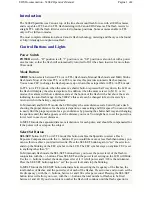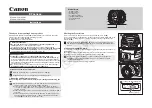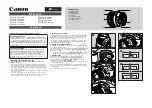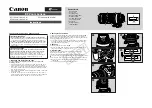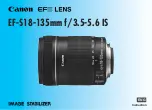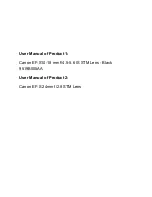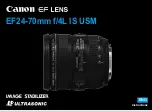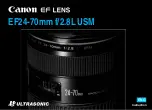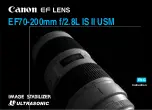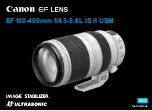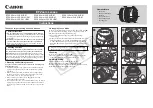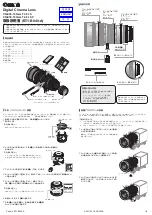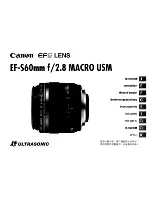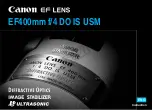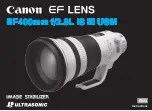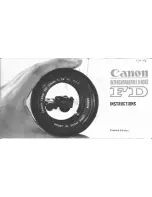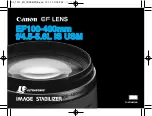
Thank you very much for purchasing a Sigma Lens. In order to get the maximum
performance and enjoyment out of your Sigma lens, please read this instruction
booklet thoroughly before you start to use the lens.
DESCRIPTION OF THE PARTS (fig.1)
DC LENS
These are special lenses that are designated for digital cameras because the lens image
circle is designated to correspond to the size of the image sensors of most digital SLR
cameras. The specialized design gives these lenses the ideal properties for digital cameras.
◆
An image sensor element larger than those corresponding to APS-C cannot be used in
digital cameras or 35mm SLR cameras. If such an element is used vignetting will occur
on the picture surface.
◆
If you use SD14 / SD10 / SD9 digital cameras, corresponding angle of view will be
30-85mm.
ATTACHING TO CAMERA BODY
When this lens is attached to the camera body it will automatically function in the same way
as your normal lens. Please refer to the instruction booklet for your camera body.
◆
On the lens mount surface, there are a number of couplers and electrical contacts.
Please keep them clean to ensure proper connection. To avoid damaging the lens, be
especially sure to place the lens with its front end down while changing the lens.
◆
Many accessories such as rear mounted teleconverters, extension tubes, etc., are
specially made for designated lenses. Before you purchase such accessories, please
check your Sigma lens to determine that it is compatible and that the accessories will
function properly with it.
SETTING THE EXPOSURE MODE
The sigma lens functions automatically after mounting to your camera. Please, refer to the
camera instruction book.
FOCUSING AND ZOOMING
《
SIGMA AF and CANON AF
》
For autofocus operation, set the focus mode switch on the lens to the “
AF
” position (fig.2). If
you wish to focus manually, set the focus mode switch on the lens to the “
M
” position. You
can adjust the focus by turning the focus ring.
《
NIKON AF and FOUR THIRDS
》
For autofocus operation, set the camera to AF mode and set the focus mode switch on the
lens to the “
AF
” position (fig.2). If you wish to focus manually, set the focus mode switch on
the lens to the “
M
” position. You can adjust the focus by turning the focus ring. (In the case
of Four-Thirds cameras it is necessary to switch the camera to MF mode as well)
《
SONY AF and PENTAX AF
》
For autofocus operation, set the camera’s focus mode to AF. If you wish to focus manually,
set the camera’s focus mode to “M” and adjust the focus by turning the focus ring.
◆
Please refer to camera’s instruction manual for details on changing the camera’s
focusing mode.
◆
The viewfinder of some Nikon AF cameras have indicators to display the focus status.
The “
●
” symbol indicates that correct focus has been set, “
►
” indicates that focus is
set in front of the subject, and “
◄
” indicates that focus is set behind the subject. When
this AF lens is used with Nikon AF cameras in MF mode, please adjust the lens’ focus
until the “
●
” symbol is visible.
◆
To avoid damaging AF mechanism, please do not turn the focus ring manually while in
the autofocus mode.
◆
When operating this lens in manual focus mode, it is recommended that correct focus be
confirmed visually in the viewfinder rather than relying on the distance scale. This is
due to possible focus shift resulting from extreme changes in temperature which cause
various components in the lens to expand and contact. Special allowance is made for
this at the infinity setting.
◆
In the case of Four Thirds lenses, the function of AF-S mode with MF override is not
available.
《
Zooming
》
Rotate the Rubber grip on the zoom ring to the desired position.
《
Zoom Lock Switch
》
This lens is also equipped with Zoom Lock Switch to eliminate the zoom creep when the
lens is tilted down. Please set zooming ring to 18mm and set the zoom lock switch to the
“LOCK” position. (fig.3)
MAGNIFICATION
The indication of the lens as “1:xx” on a focusing distance scale represent the magnification
(commonly called the reproduction ratio). For example when you are in focus at the “1:3”
position on the scale, a subject with an actual size of 3cm will have an image size of 1cm
on the firm. (fig.4)
LENS HOOD
A bayonet type detachable hood is provided with the lens. This lens hood helps to prevent
flare and ghosted images caused by bright illumination from outside the picture area.
Attach the hood and turn clockwise until it stops rotation. (fig.5)
◆
When taking photographs using the built-in flash, it is advisable to remove the lens hood so
as to avoid cutting off any of the flash output, which could cause a shadow in the picture.
◆
In order to place the lens and hood into the storage case, you must first remove the
hood, then replace it on the lens in the reverse position. (fig.6)
FILTER
◆
Only one filter should be used at the time. Two or more filters and/or special thicker
filters, like a polarizing filter, may cause vignetting.
◆
When using a polarizing filter with AF camera, use the “circular” type.
BASIC CARE AND STORAGE
◆
Avoid any shocks or exposure to extreme high or low temperatures or to humidity.
◆
For extended storage, choose a cool and dry place, preferably with good ventilation. To
avoid damage to the lens coating, keep away from mothballs or naphthalene gas.
◆
Do not use thinner, benzine or other organic cleaning agents to remove dirt or finger prints
from the lens elements. Clean by using a soft, moistened lens cloth or lens tissue.
◆
This lens is not waterproof. When you use the lens in the rain or near water, keep it
from getting wet. It is often impractical to repair the internal mechanism, lens elements
and electric components damaged by water.
◆
Sudden temperature changes may cause condensation or fog to appear on the surface
of the lens. When entering a warm room from the cold outdoors, it is advisable to keep
the lens in the case until the temperature of the lens approaches room temperature.
TECHNICAL SPECIFICATIONS
Lens construction
13 – 15
Angle of View
69.3 – 27.9°
Minimum Aperture
22
Minimum Focusing Distance
0.2m (0.65 ft)
Magnification
1:3
Filter Size
72mm
Dimensions Dia.
×
Length
79
×
85.7mm (3.11
×
3.37 in)
Weight
450g (15.9 oz)
Dimensions and weight include the SIGMA mount.
The CE Mark is a Directive conformity mark of the European
Community (EC).
SIGMA (Deutschland) GmbH
Carl-Zeiss-Str. 10/2, D-63322 Rödermark, F.R.GERMANY
Verkauf: 01805-90 90 85-0 Service: 01805-90 90 85-85 Fax: 01805-90 90 85-35
①
Filter Attachment Thread
②
Focus Ring
③
Distance Scale
④
Focus Index Line
⑤
Zoom Ring
⑥
Focus Mode Switch
(SIGMA SA / CANON AF / NIKON / FOUR THIRDS)
⑦
Mount
⑧
Lens Hood
⑨
Zoom Lock Switch
ENGLISH


